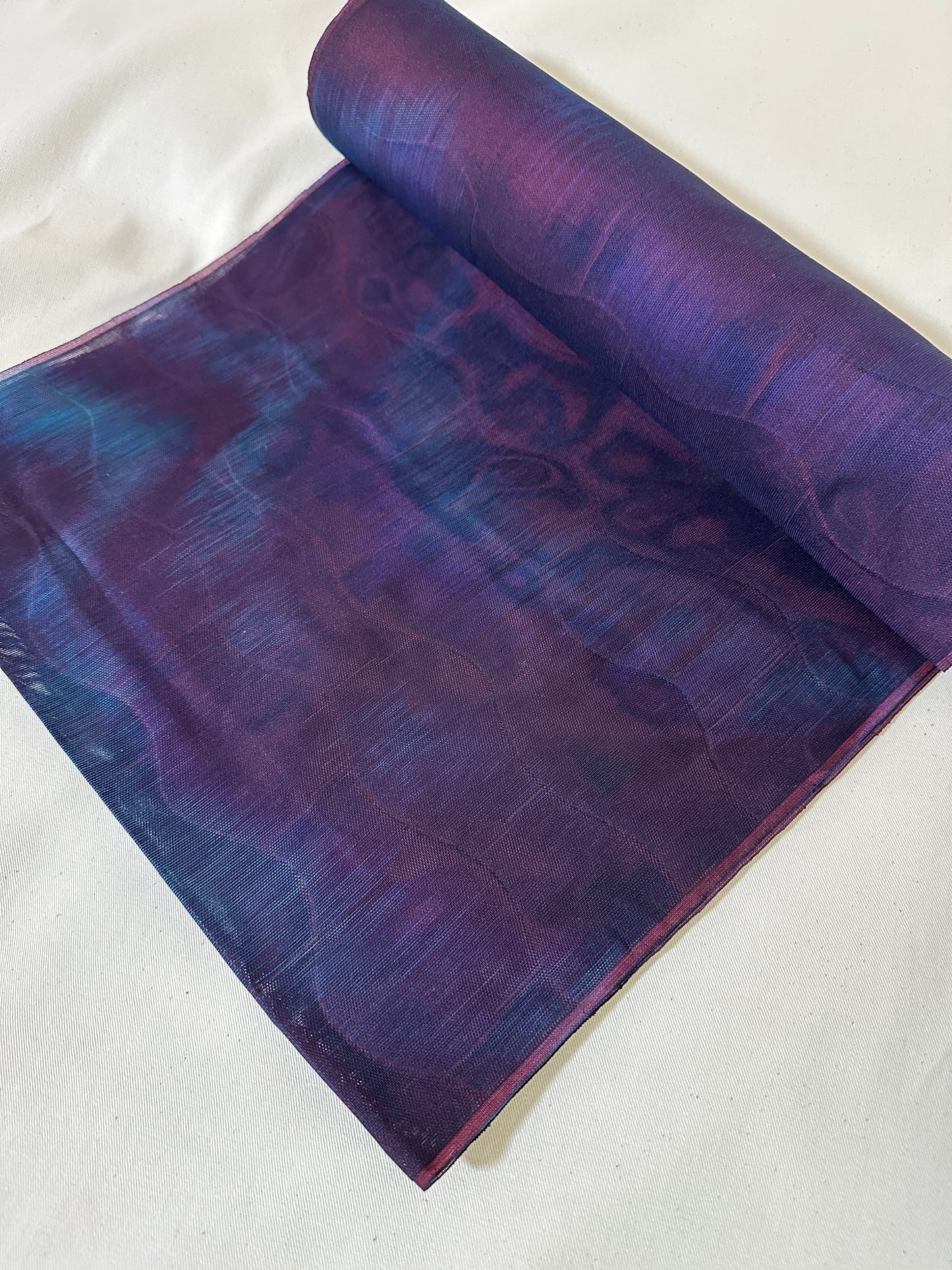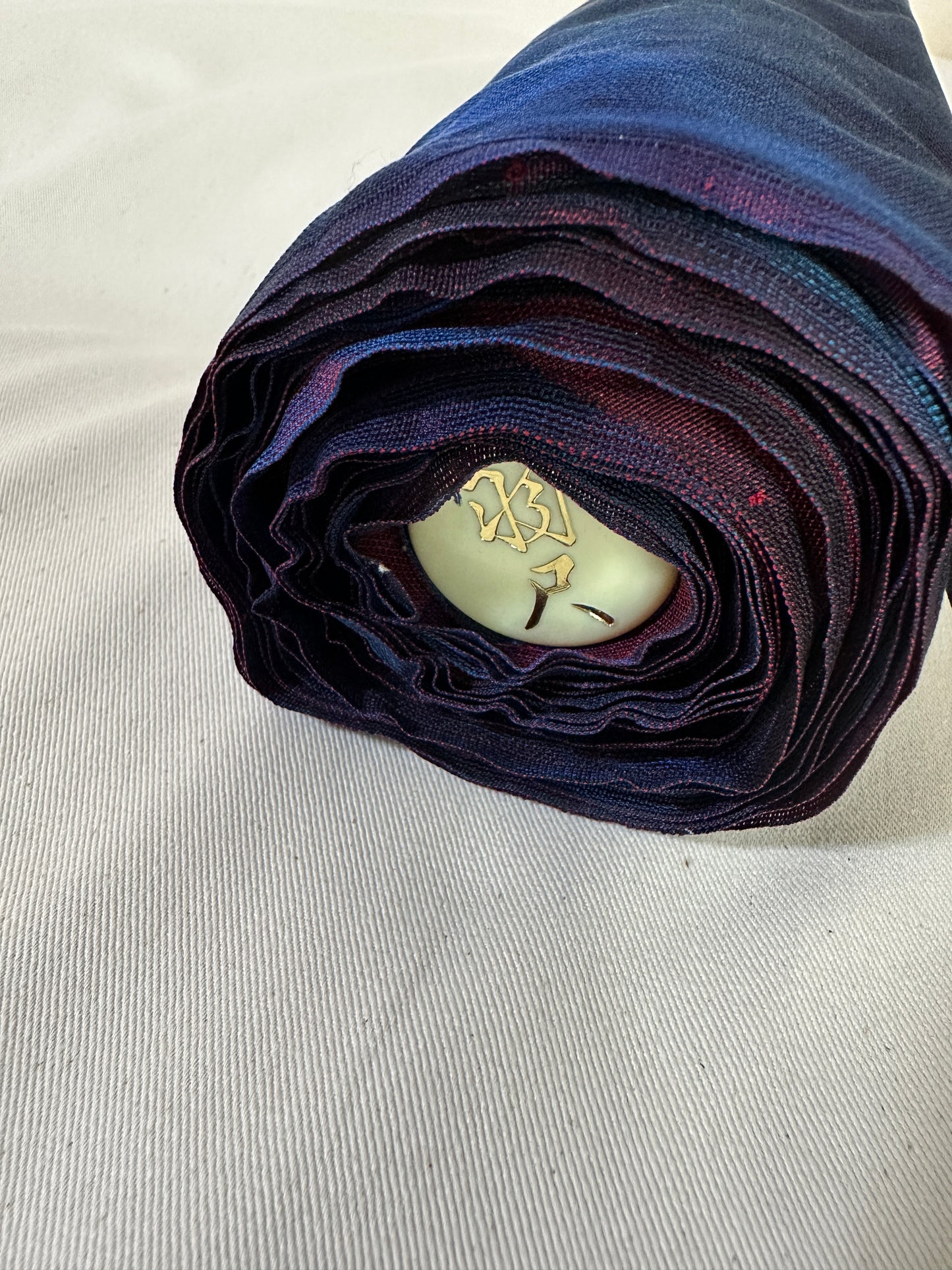MACHIKO KIMONO Japanese Kimonos, Vintage & Upcycled
KIMONO TANMONO / Long-term unused product / SHA / MURASAKI
KIMONO TANMONO / Long-term unused product / SHA / MURASAKI
Couldn't load pickup availability
KIMONO TANMONO / Long-term unused product / SHA
One-of-a-kind-vintage.
*Modern and never used.
[Color]
Front Brown, purple
Back side Red
[Fabric] 100% silk
There are two types of Japanese kimonos traditionally worn in the summer: "ro" and "sha." Both are made of silk. (Some recent ones have synthetic fibers. ) Kimono fabrics of "ro" and "sha" are sheer and beautiful.
This fabric is "sha."
It features a beautiful transparent material.
[Size] Width: approx. 37 cm
A whole roll of cloth UJYAKU 羽尺 2丈6尺(approx. 9.8m)
[Care] Dry clean.
[Condition] Very good.
*This fabric is unused and will be delivered without kimono cleaning. If you wish to have your kimono professionally cleaned, please contact us.
*Please understand that there may be stains and slight damage common in vintage fabrics as all of our clothes are made by either partial or full disassembly of the original kimono.
SHIPPING & RETURNS, DETAILS
SHIPPING & RETURNS, DETAILS
WE SHIPPING WORLDWIDE
Shipping to US, UK, France, Italy, Canada, Australia, Finland and Mexico is no issue! We have shipped to happy customers in many countries. If your country isn’t listed yet please reach out and we can inquire with our shipping company.
FROM TIME OF ORDER UNTIL SHIP DATE
Almost all items will be sent for professional kimono cleaner after purchase. Please allow up to 10 business days from date of order until shipment.
*International delivery times can vary due to customs.
ALL ITEM, NO RETURN or NO REFUND. (ALL SALES ARE FINAL)
Please check the measurements and conditions before purchasing.
- As all product prices include international shipping costs, if a package is returned to us due to customer circumstances and a refund is requested, the shipping cost portion will be deducted from the refund. We appreciate your understanding.
- Some countries such as EU member states or the United Kingdom may require that consumers are granted the right to return items within 14 days of receipt. If you live in such a country, please contact us in advance if you need clarification on your right to return.
Please be aware that certain items may not be returnable due to their custom-made or upcycled nature.
SHIPPING METHOD
We prepare multiple shipping options, including Japan Post EMS, FedEx, and DHL, to adapt to changing global circumstances. The choice of carrier will be made by us to ensure the fastest and safest delivery to your location. Thank you for your understanding.
CONTACT
Please feel free to contact us by email at contact@machikokimono.com or via Instagram DM.
The buyer understands and agrees that any purchase from the site is a personal purchase from the seller, which is a private activity.
REGARDING VAT/ IMPORTING TAX
REGARDING VAT/ IMPORTING TAX
Thank you for your understanding that any customs charges and tax upon delivery which the customer is responsible.
*The prices shown in my website do not include such items as VAT, import duty, tax and other unpredictable charges against middleman. In case of these unexpected charge needed in the due course, these charges should be paid by the customers. For more information regarding your country’s customs policies, please contact your local customs office or its agents.
Thank you for your understanding.
*Thank you for your understanding that the buyer has responsible for local laws and regulations.
ABOUT MATERIAL COMPOSITION
ABOUT MATERIAL COMPOSITION
Most vintage and antique kimono and haori do not have fabric composition labels. These garments were custom-tailored for individual clients, and the material details were rarely recorded directly on the garment.
Today, only mass-produced kimono sold in major retail stores include such tags. Traditionally tailored kimono—even those made in recent decades—usually do not have any sewn-in fabric composition labels.
As a result, determining the exact composition of vintage fabrics is not always possible. Based on my experience as a licensed antique art dealer and upcycling artist, I examine the fabric using visual texture, burn tests, and the known age of the kimono to make an educated guess.
If I’m confident it is 100% silk, I will label it as such.
If the fabric shows characteristics of mixed fibers or modern synthetics, I will label it as “silk & more.”
Please understand that:
I do my best to make careful judgments, but these are not lab-certified.
If you require an exact determination, I recommend using a fabric testing service in your country.
Many kimono are hand-sewn by specialized Japanese artisans called “wasai-shi”. In rural Japan, it was common during the post-war years for farmers to sew kimono during winter months for clients in cities like Kyoto or Tokyo.
I continue this tradition by giving new life to these beautiful garments. Thank you for your understanding and support.
Share


Please note that the buyer is responsible for any import duties, VAT, customs charges, and compliance with local laws and regulations in their country.
I ordered this roll of beautiful vintage silk tanmono from Machiko San, and I am so happy that I did! It is a gorgeous woven silk: double-sided. It appears to be woven from kasuri dyed silk threads. One side is deep indigo blue, the other a rich red. There are actually two layers of woven silk, integrated together with wavy lines. I have never seen this style of fabric before, it is very special!
My order arrived in 8 days, shipped from Japan to the US. Machiko San was so good about sending emailed updates and tracking information. The carrier required a signature when it arrived at my house, which I appreciate.
As with many vintage fabrics, this tanmono had an odor to it. I took a chance, after doing some research, and hand washed the fabric instead of dry cleaning. I first hand washed it in cool water using a natural detergent. Next I hand washed it using Synthrapol, which helps remove excess dye. After rinsing, I hand washed one more time using Retayne, which helps keep the dye from bleeding any further. A lot of dye came out of the fabric through the process, but it appears to be exactly the same color now that it is dry, clean, and ironed. I dried it on a clothing rack outdoors in the sunshine, then ironed it using a steam iron. I was lucky that hand washing worked well, and did not change the fabric. Please use your own best judgement, and perhaps wash a small test piece before washing an entire vintage tanmono.
Thank you, Machiko San! I am a happy customer!
Let customers speak for us
from 84 reviewsThis garment is impeccably sewn. The patterns were tediously matched up to perfection. The seaming where did she go? Where’d you go is beautiful and the presentation when opening your package is absolutely beautiful. You feel like you’re opening something’s very special..

An absolutely one-of-a-kind vintage kimono, filled with care, devotion, and exceptional craftsmanship. I truly admire how tradition is so respectfully preserved, yet expressed in a way that feels wearable, alive, and relevant today. Holding and wearing this kimono feels like experiencing a piece of living art — perfection in every detail.

5 star shop , correct and perfect clothes
Thank you 👍

黒留袖は、ずっと「かっこいい着物」だと思っていました。
けれど実際には、結婚式での主賓や家族など、着る機会がとても限られていることが少し残念でもありました。
──でも、リメイクという選択肢がありました。
今回、表彰式に招かれました。
ドレスコードは “Formal”。
洋装で言えば、女性はイブニングドレス、男性はタキシードという世界です。
その場に、MachikoKimono の黒留袖リメイクの巻きスカートと、紋付の黒い羽織で伺いました。
それはまさに、着物における最高位のドレス。
会場でも違和感はまったくなく、むしろ
「日本の Black Dress ですね」「素敵なお召物ね」「着物?あ、洋服!かっこいい!」
そんな言葉をかけていただきました。
伝統の格と美しさをそのままに、現代のフォーマルな場へと連れて行ってくれる。
黒留袖が、こんなにも自由に、誇らしく輝けることを教えてもらいました。
この一着のおかげで、忘れられない表彰式になりました。
心からの感謝を込めて。

The IROTOME SKIRT, reborn from the soul of a Japanese kimono, is more than a garment—it is a story whispered in silk. Its shape flows like a quiet river, graceful and timeless, while the quality and finishing speak of hands that honor craft with devotion.
From the first moment, the experience felt like an art form. The care in communication, the kindness in service, and then—the packaging. Wrapped as if carrying centuries of tradition, echoing the way kimonos once traveled, it arrived like a gift from another era.
This is not just a purchase; it is an encounter with beauty, heritage, and respect. I recommend these creations wholeheartedly, for they do not merely dress the body—they celebrate the spirit.

Perfectly sewed, kind of art, very special, beautiful clothing, very nice handwritten greetings included

Shipped super fast! The fabric is beautiful heavier vintage silk; I like how it is a modern take on kimono I can wear on more occasions. Came beautifully packaged in a kimono box as well. For anyone wondering how long it is; I am 5’2”
I love my new kimono. It is beautifully made and so easy to wear. Thank youl

Fantastic quality antique kimono in beautiful condition.

This "Fuji-San" Haori is an absolutely perfect piece. I will be using it for my wedding and I could not be more excited to have this. Machiko not only provide great quality pieces but the service and care provided far exceed the cost. The Haori was beautifully packaged, came with a beautiful note and with a Haori-Himo which perfectly matches the colours in the design. I could not be happier with the decision I made to order this piece, there could not be a better piece to honour my Fiance's family and her heritage.
Thank you again Machiko, and all the best!

Today I received my kimono "sha, ryusui" ... and how beautiful it is ... what also surprised me was the way it was packed ... beautiful, a handwritten message and a beautifully folded geisha-like something ... a lot of attention was paid to even a storage packaging for the kimono ... but the kimono itself looked beautiful ... I am from the Netherlands and am elderly ... and yet it fit ... if I get the opportunity to order one again in the future then I know I'll do it at machiko...thank you very much.

Absolutely love these beautiful socks!
These socks are truly a work of art. The floral motif is beautifully designed and it adds a special touch when wearing a skirt or a dress.
I was equally impressed by Machiko. She was attentive and ensured that my order arrived safely. The socks were beautifully packaged with a personal message .
I could not be happier with my purchase - thank you Machiko. ❤️

Wearing it is very simple: it’s not an overly flashy kimono and pairs easily with "Western-style clothing" , remaining discreet yet captivating.

Beautiful kimono, excellent quality.
Great communication.
Highly recommend.

I just received this Haori and I’m extremely happy with it! The fabric is beautiful and has so many small and fine details, and it’s much more beautiful in person. This piece undoubtedly was kept in great care. I will definitely come back in the future :)




